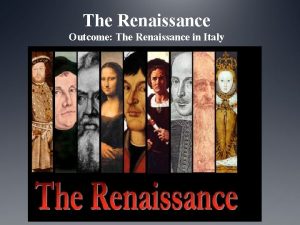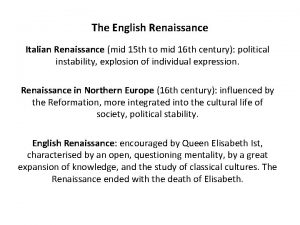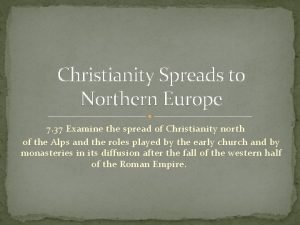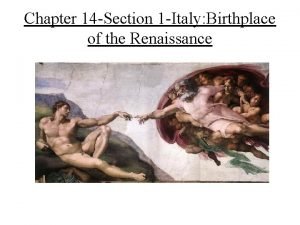The Renaissance Italian CityStates CityStates Italy was the







- Slides: 7

The Renaissance Italian City-States


City-States � � � � � Italy was the leading center of the Renaissance. The leading city-states in Italy were Florence, Venice, and the Papal States. The Papal States included Rome and, they were ruled by the Pope. The city-states were wealthy from trade. Powerful individuals or families took control of cities. They fought each other for land power. The leaders spent money on ceremonies and parades to impress and entertain the people. They built churches and palaces. They encouraged scholars to set up schools for the sons of the rich. In school they studied classical writings and learning good manners. The rest of the day they wrestled, fenced, and swam.

Art � Art was important in Renaissance Italy. � City-states competed for the services of the best painters and sculptor. � Artists began to develop their own style. � They studies Greek and Roman art, science, and math. � They drew the human body accurately. � Their art was full of color and action. � Artist were paid by the rulers of the city-states. � The artists made paintings and sculptures for the rulers. � Artists trained apprentices in their workshops.

Activity �You will be divided into 4 groups. �Each group is responsible for making a poster on one of the following topics: ü Italian City-States ü Milan ü Venice ü Florence § Each group will be provided with reading material and paper to create their poster on.

City Life � Italian Renaissance cities had narrow paved streets. � Open sewers ran through the middle. � Shopkeepers and merchants lived on the top floors of their buildings. � The rich lived in homes with large rooms and high ceilings. � The rooms were built around a central courtyard. � The poor worked for low wages and lived in run-down areas.

Sports and Games � The ideal person participated in a variety of activities. � Javelin hurling, chess, archery, fencing, boxing, snowball fights, and gambling. � Women participated in many sports including giuco della palla, which became tennis.













